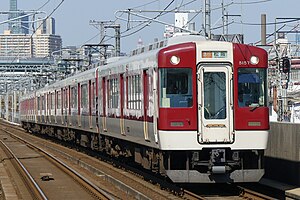Japanese train type
The Kintetsu 5200 series (近鉄5200系 is an electric multiple unit (EMU) train type operated by Kintetsu Railway in Japan on limited express services on the Osaka and Nagoya Lines .[ 2]
Variants
5200 series: 4-car sets which are designated as the first batch introduced in 1988.[ 3] 5209 series: 4-car sets with backup auxiliary power source switched to a static inverter introduced in 1991.[ 3] 5211 series: 4-car sets with modified bogies introduced in 1993.[ 3]
Overview
5200 series sets are formed as follows.[ 4]
Car
1
2
3
4
Designation
Tc
M
M
Tc
Numbering
5100
5200
5250
5150
Interior
Seating consists of perpendicular seating throughout.
Interior after refurbishment work
Wheelchair space added after refurbishment
Upgraded onboard washroom facilities
History
The trains were introduced in 1988 to fulfill a need for long-distance services as well as for replacing aging 2600 series trainsets.
The design of the trains revolved around three principles:[ 5]
More comfortable
Multi purpose (Vehicles suitable for morning and evening commuting, daytime long-distance express transportation, and for private charters)
Modern technology (For ease of maintenance) In 1988, the series won the Good Design Award by the Japan Institute of Design Promotion .[ 3]
In September 2014, set 5205 was repainted in a commemorative livery from the 1960s.[ 6]
References
^ a b c 三好好三 (2016). 近鉄電車 [Kintetsu train ] (in Japanese). JTB Publishing. p. 125. ISBN 9784533115318 ^ a b 近畿日本鉄道のひみつ The secret of Kintetsu Railway ] (in Japanese). Tōkyō: PHP Kenkyūjo. 2013. pp. 118– 119. ISBN 978-4-569-81142-0 OCLC 848597940 .^ a b c d 河久, 諸; 山邊誠 (1998). 日本の私鉄近鉄 II [Japanese Private Railway Kintetsu II ] (in Japanese). Hoikusha. p. 62. ISBN 9784586509058 ^ 私鉄車両編成表2021 [Private Railway Vehicle Organization Table 2021 ] (in Japanese). Japan: Kotsu Shimbunsha. 16 July 2021. p. 130. ISBN 9784330032214 ^ "鉄道ファン" [Railway Fan]. 鉄道ファン (in Japanese). 326 : 81– 85. June 1988. ^ "近鉄エリアキャンペーン記念列車」が出場" ["Kintetsu area campaign commemorative train" participates]. Japan Railfan Magazine Online (in Japanese). Japan: Koyusha Co., Ltd. 11 September 2014. Retrieved 27 January 2022 .
External links





